Buddha and Buddhism
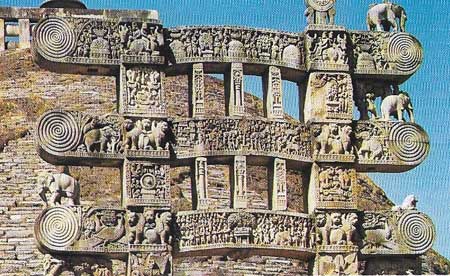
Figure 1. The great departure from Kapilavastu is often represented in Buddhist art. Although the future Buddha left secretly at night, sculptors usually show the pomp of a royal procession.
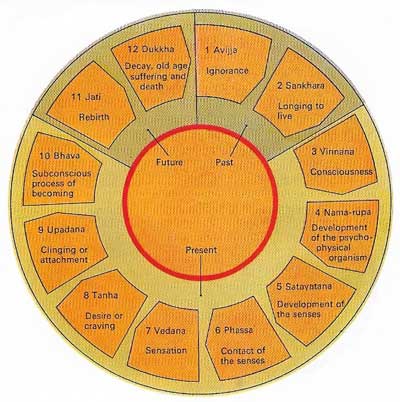
Figure 2. In Buddhist philosophy, the Wheel of Existence consists of 12 spokes, each constituting a link in the ever-repeated cycle of life and death. The wheel will revolve as long as ignorance lasts.
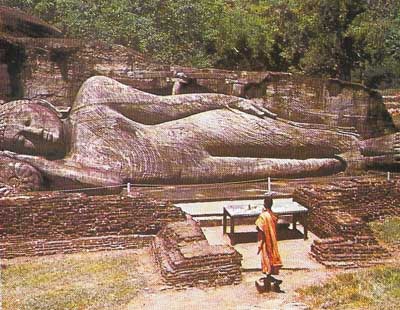
Figure 3. The fourth great event in Buddha's life is the nirvana, which is neither eternal life nor annihilation but an incomprehensible state of utter bliss. He Buddha is shown in a symbolic representation of the state of nirvana. This huge sculpture at Gal Vihara, Polannaruva, Sri Lanka, dates from the twelfth century.
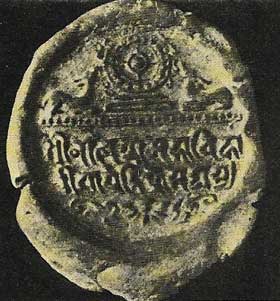
Figure 4. The Wheel of Law and two deer on this seal suggest the Deer Park of Sarnath. The seal was recovered from the ruins of Nalanda, a great Buddhist monastery in Bihar. Founded in the 5th century, Natanda became one of the great centers of Buddhist learning, attracting students even from Indonesia and China and enjoying the patronage of numerous kings. The Muslims largely destroyed it in c. 1200.

Figure 5. Borobudur, situated in the heart of Java, is often described as a stupa (dome-shaped shrine) but although a stupa crowns it, the rest of the structure predominates. It is a marvelous storehouse with five lavishly decorated galleries exhibiting pious stories in 1,500 relief panels. It was built by the Sailendras, a Buddhist dynasty in Java from about 750 to 850.
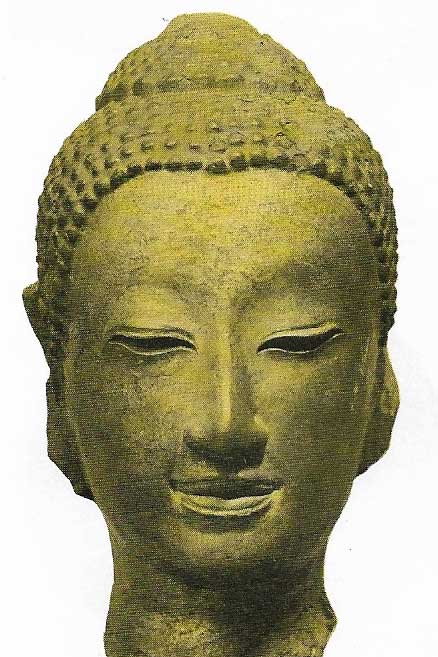
Figure 6. The Mons of southern Thailand and the Thais of central Thailand became Buddhists by the third century. Despite the Khmer occupation, Buddhism continued to flourish. This Buddha head comes from Lop-burl. Although con-forming to Buddhist norms, it was modeled to correspond to the aesthetic ideals of the Thais.
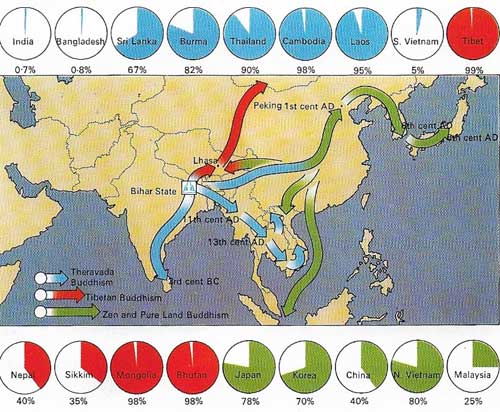
Figure 7. The expansion of Buddhism outside India was a complicated process extending over many centuries. Here the broad outlines of its spread are shown, together with the percentage of Buddhists in various countries today. Buddhism was spread by monks who some-times acted as advisers to kings.
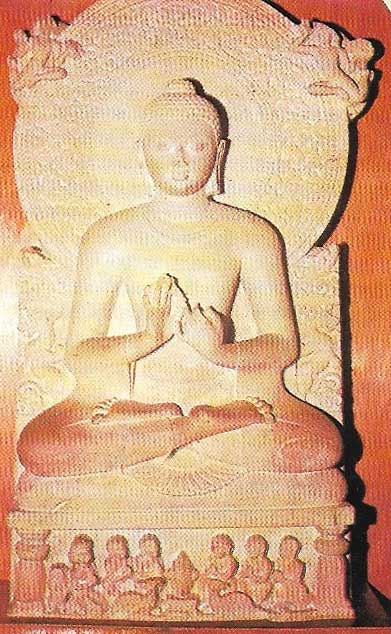
Figure 8. In the life of Lord Buddha the first sermon is the third great event (after his birth and "enlightenment"). Buddhists call this event the "turning of the wheel of Law"; the wheel represents the cosmos, and the Law represents the Lord Buddha's philosophy, which offers an explanation of the mysteries of life. The presence of the wheel is suggested by the position of the hands. The sculpture of Sarnath dates from the Gupta period, (c. AD 500). The perfection of the physical shape reflects perfect knowledge; the elongated ears and almond-shaped eyes suggest pro-found concentration and the monastic robe reveals the perfect body.
By the 6th century BC the seminomadic tribes of northern India had developed into settled agricultural communities ruled by oligarchies or royal dynasties. It was a time of social change and of new ideas. Chief among these, and evolved in opposition to the rituals and hardening caste system of Hinduism, were the philosophical and ethical teachings of Buddhism which were to develop into one of the greatest Oriental religions.
The life of Buddha
There are many differing accounts of the life of Buddha but the main outline seems clear. Siddhartha Gautama (c. 563–c. 483 BC), who was later to become the Buddha ("the Enlightened One"), was the son of Suddhodana, king of the Sakyas, and his queen Maya. His birthplace, Lumbini, is situated On the northern fringes of the Gangetic valley near Kapilavastu where he spent his early years. After an uneventful childhood the prince, struck by the problem of human suffering, decided to break with the past to seek the supreme truth in meditation. He left home secretly (Figure 1) and eventually, after years of seclusion, he attained "enlightenment" seated under the Bodhi tree at Bodhgaya near Gaya in southern Bihar. This subsequently became one of the holiest places of Buddhism and saplings of the tree were taken to different Buddhist countries where they grew into new trees. Soon afterwards the Buddha delivered his first sermon in the Deer Park of Sarnath (Figure 4) near Varanasi "setting the wheel of the Law in motion" (Figure 8).
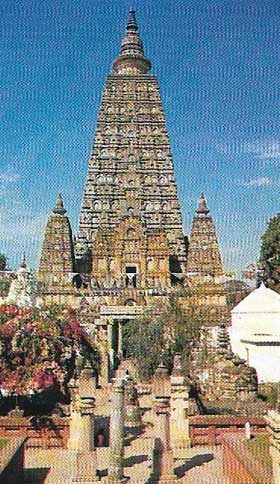 |
| The Mohabodhi Temple, Bodhgaya, Bihar, marks the spot where Lord Buddha attained "enlightenment" seated under the Bodhi tree. This is perhaps the most hallowed spot in the Buddhist worked. The present temple, which replaces an older foundation at the site, was built in the Gupta period (c. 320–c. 550) but has been restored. |
Buddhist doctrine was a Middle Way, avoiding the extremes of mortification and indulgence. It accepted the basic concepts of Hinduism – rebirth and the law of karma, that a man's actions directly control his destiny – but concentrated on ethics as a means to salvation. For Buddha suffering was caused by desire. The abandonment of desire could be achieved by following the "noble eightfold path" of right living and actions. As a result nirvana, the state of bliss in which rebirth ended, would be attained. The ideal of nirvana (Figure 3) could best he attained by monastic discipline, but the order of monks (Sangha) depended on the entire community.
Buddha himself preached all over eastern India and received support from the rulers and the emerging merchant class. When at an advanced age he "entered nirvana", he left a monastic order but no written instructions.
Expansion of Buddhism
For two centuries Buddhism slowly expanded despite difficulties such as the animosity of the Hindu Brahmins who feared for their own privileges. However, when the Indian king Ashoka (reigned c. 274–c. 236 BC) was converted to Buddhism his powerful patronage greatly favored its expansion. The oldest extant stupas, distinctive monuments built to enshrine relics, belong to this period. Through Ashoka's influence Buddhism was introduced into Sri Lanka, where it has remained the established faith.
For the next few centuries Buddhism spread farther into India with centers located in central India (Bharhut, Sanchi), Maharashtra and Andhra Pradesh where Buddhist art and architecture flourished. In Maharashtra (Nasik, Karle and other places), many caves served as monasteries or halls for worship (the chaitya halls). Great stupas (Amaravati and Nagarjunakonda) also arose in the Andhra country.
Buddhism was always prone to divisions and councils organized to promote unity often had the opposite effect. Early in the Christian era there developed a fundamental division between the adherents of the Great Vehicle (Mahayana) and those of the Lesser Vehicle (Hinayana). The former had monks but emphasized the ideal of the pious layman continually assisting his fellow men by his wisdom and compassion. The historical Buddha and previous Buddhas were worshipped as deities and so were other beings who had taken the vow to become Buddhas (Bodhisattvas). Buddhas and Bodhisattvas received worship in the form of images, thus providing a strong incentive to Buddhist art, which soon included the image of Lord Buddha. Hinayana, however, kept closer to the other teachings.
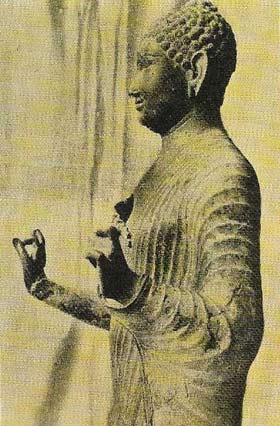 |
| One of the oldest-known Buddhist images in Southeast Asia is this bronze Buddha from Vietnam, dating back to the fifth century. Its style was influenced by Buddhas from Amaravarti. |
The spread outside south Asia
From the beginning of the Christian era Buddhism spread outside south Asia (9). Buddhism entered China in the 1st century and subsequently spread to Korea and Japan. In Tibet it took root in the 8th century and developed into Lamaism.
In Southeast Asia, too, Mahayana influence, mainly from Bengal, inspired great monuments such as Borobudur in central Java (9th century) (Figure 5) and Bayon in Cambodia (12th century), but the great expansion of the Theravada school (the monastic version of Hinayana) gained momentum in the 11th century when the Burmese king Aniruddha (reigned 1044–1077) made Theravada the official religion. In the 13th century it became the official religion of Thailand and eventually spread to Laos and Cambodia.
Although it has not always guaranteed harmony between these countries, Buddhism has provided Sri Lanka and mainland Southeast Asia with a firm ideology and a high standard of education. It has also contributed to great achievements in art and architecture. The astounding temple complex of Pagan (Burma), the splendid pagodas of Mandalay, Bangkok and Ayutha (Thailand), testify to the strength and inspiration of the faith.
